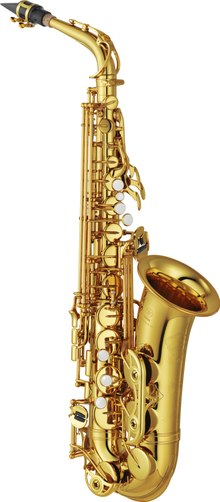Alto sax
 |
|
| Woodwind instrument | |
|---|---|
| Classification | |
| Hornbostel–Sachs classification | 422.212-71 (Single-reeded aerophone with keys) |
| Inventor(s) | Adolphe Sax |
| Developed | 28 June 1846 |
| Playing range | |
|
In E♭: sounds a major sixth lower than written. Most modern alto saxophones can reach a high F♯ |
|
| Related instruments | |
|
Military band family:
Orchestral family: Other saxophones:
|
|
| Musicians | |
| More articles | |
Military band family:
Orchestral family:
Other saxophones:
The alto saxophone, also referred to as alto sax, is a member of the saxophone family of woodwind instruments invented by Belgian instrument designer Adolphe Sax in the 1840s, and patented in 1846. It is pitched in E♭, and is smaller than the tenor, but larger than the soprano. The alto sax is the most common saxophone and is commonly used in classical music (such as concert bands, chamber music, and solo repertoire), military bands, marching bands, and jazz (such as big bands, jazz combos, swing music). The alto saxophone was also commonplace in popular music from the 1980s and early 1990s with the saxophone solo at the bridge of the song. The saxophone fingerings are all universal, so a saxophone player can play any type of saxophone.
The range of the alto saxophone is from concert D♭3 (the D♭ below middle C—see Scientific pitch notation) to concert A♭5 (or A5 on altos with a high F♯ key). As with most types of saxophones, the standard written range is B♭3 to F6 (or F♯6). Above that, the altissimo register begins at F♯6 (or G6) and extends upwards. The saxophone's altissimo register is more difficult to control than that of other woodwinds and is usually only expected from advanced players. By covering or partially covering the bell of the saxophone when playing B♭3, it is possible for the alto saxophone to reach A3 as well.
...
Wikipedia

